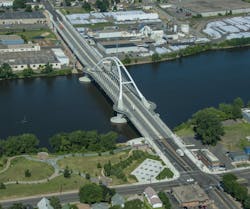2013 Top 10 Bridges - No. 5
Project: Lowry Avenue Bridge
Location: Minneapolis
Owner: Hennepin County
Designers: SRF Consulting Group; T.Y. Lin International
Contractor: Lunda Construction Co.
Cost: $88.5 million
Start Date: July 1, 2007
Completion Date: Oct. 27, 2012
New span a sight to see
Lowry Avenue Bridge adds new attraction to Minneapolis skyline
If you’ve traveled through northeast Minneapolis anytime in the last year, you probably noticed the new bridge that is literally lighting the way for motorists across the Mississippi River.
Originally constructed in 1904, the Lowry Avenue Bridge in Minneapolis had received a major lift in the late 1950s, when the superstructure was replaced and raised. At the time, the new river piers were constructed around the originals, Rick Brown, P.E., of SRF Consulting Group told Roads & Bridges.
During some regularly scheduled maintenance in 2007, however, bridge owner Hennepin County discovered that one of the river piers was actually moving. This was more than enough to spur the county into action.
When the project team spoke to the local community, they found that many of them liked the design of the old bridge, which was a simple through-truss configuration. “They liked being able to see the guts of the bridge as you drove through it,” said Brown. At the same time, the city had plans to convert the industrial area to park space and wanted something a little more eye-catching. So SRF and T.Y. Lin International decided to make the new span a tied-arch bridge.
Rather than a straight tied arch, the Lowry Avenue Bridge uses what Brown calls a “basket handle” configuration, which was dreamed up by T.Y. Lin. In this case, the two main arches are not perfectly vertical, angling in 20° from the vertical at the top.
Being in the middle of a heavily traveled urban corridor, the right-of-way was “incredibly tight,” Brown said. SRF and contractor Lunda Construction Co. expanded the bridge from two lanes to four and eliminated a curb wall embankment, along with other measures intended to open up the space for future land-use plans.
To truly make the new Lowry Avenue Bridge a stand-out Minneapolis landmark, SRF decided to cover the bridge facade in color-changing LED lights. “It’s not the most convenient thing to go up on the bridge and change light bulbs,” Brown joked about the reason for using longer-lasting LEDs.
The lights can be changed to celebrate any situation or season, from green for St. Patrick’s Day to purple and gold for Minnesota Vikings football games.
In addition to creating the bridge itself, the project team designed and installed an underground sand filter to treat storm water from the bridge site and the surrounding 127-acre area. At 100 ft long and 40 ft wide, it is the largest filter of its kind in the upper Midwest. R&B
